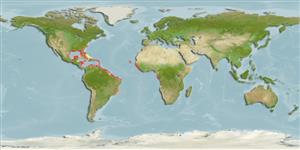Environment: milieu / climate zone / depth range / distribution range
Ökologie
seewasser demersal; tiefenbereich 21 - 70 m (Ref. 2683), usually ? - 50 m (Ref. 26999). Subtropical; - 25°S
Western Atlantic: Bermuda and southern Florida, USA to Brazil. Lesser Antilles (Ref. 26938). Eastern Atlantic: Senegal to Angola (Ref. 4455). Doubtful record from the western Mediterranean (Ref. 13729).
Size / Gewicht / Alter
Maturity: Lm ? range ? - ? cm
Max length : 210 cm TL Männchen/unbestimmt; (Ref. 26938); common length : 100.0 cm TL Männchen/unbestimmt; (Ref. 5217)
Body pale, dark band across back of head (Ref. 26938).
Maximum depth from Ref. 126840. Lives in a permanent burrow, often in very shallow water. Heads protrude diagonally from the sand. Nocturnal. Feeds on octopus and fish (Ref. 5217). Bold and easily approached. Feared by fishers (Ref. 9710). Rarely consumed (Ref. 3795).
Life cycle and mating behavior
Geschlechtsreife | Fortpflanzung | Ablaichen | Eier | Fecundity | Larven
Böhlke, J.E., 1981. Ophichthidae. In W. Fischer, G. Bianchi and W.B. Scott (eds.) FAO species identification sheets for fishery purposes. Eastern Central Atlantic, (Fishing Areas 34, 47 (in part)), Vol. 3, [var. pag.]. FAO, Rome. (Ref. 3651)
IUCN Rote Liste Status (Ref. 130435)
Bedrohung für Menschen
Reports of ciguatera poisoning (Ref. 30911)
Nutzung durch Menschen
Fischereien: kleinfischerei; Köder: usually
Mehr Information
NamenSynonymeMetabolismusRäuberÖkotoxikologieFortpflanzungGeschlechtsreifeAblaichenSpawning aggregationFecundityEierEientwicklung
Alter/GrößeWachstumLänge-GewichtLänge-LängeLängenhäufigkeitenMorphometrieMorphologieLarvenLarven Pop.Dyn.RekrutierungDichteBRUVS
ReferenzenAquakulturAquakultur ProfilZuchtlinienGenetikElectrophoresesVererbbarkeitKrankheitenVerarbeitungNutrientsMass conversion
Tools
Zusatzinformationen
Download XML
Internet Quellen
Estimates based on models
Preferred temperature (Ref.
123201): 19.2 - 27.5, mean 24.8 °C (based on 156 cells).
Phylogenetic diversity index (Ref.
82804): PD
50 = 0.5000 [Uniqueness, from 0.5 = low to 2.0 = high].
Bayesian length-weight: a=0.00089 (0.00039 - 0.00204), b=3.00 (2.80 - 3.20), in cm total length, based on LWR estimates for this (Sub)family-body shape (Ref.
93245).
Trophic level (Ref.
69278): 4.5 ±0.80 se; based on food items.
Widerstandsfähigkeit (Ref.
120179): sehr niedrig, Verdopplung der Population dauert mehr als 14 Jahre. (Preliminary K or Fecundity.).
Fishing Vulnerability (Ref.
59153): Very high vulnerability (90 of 100).
